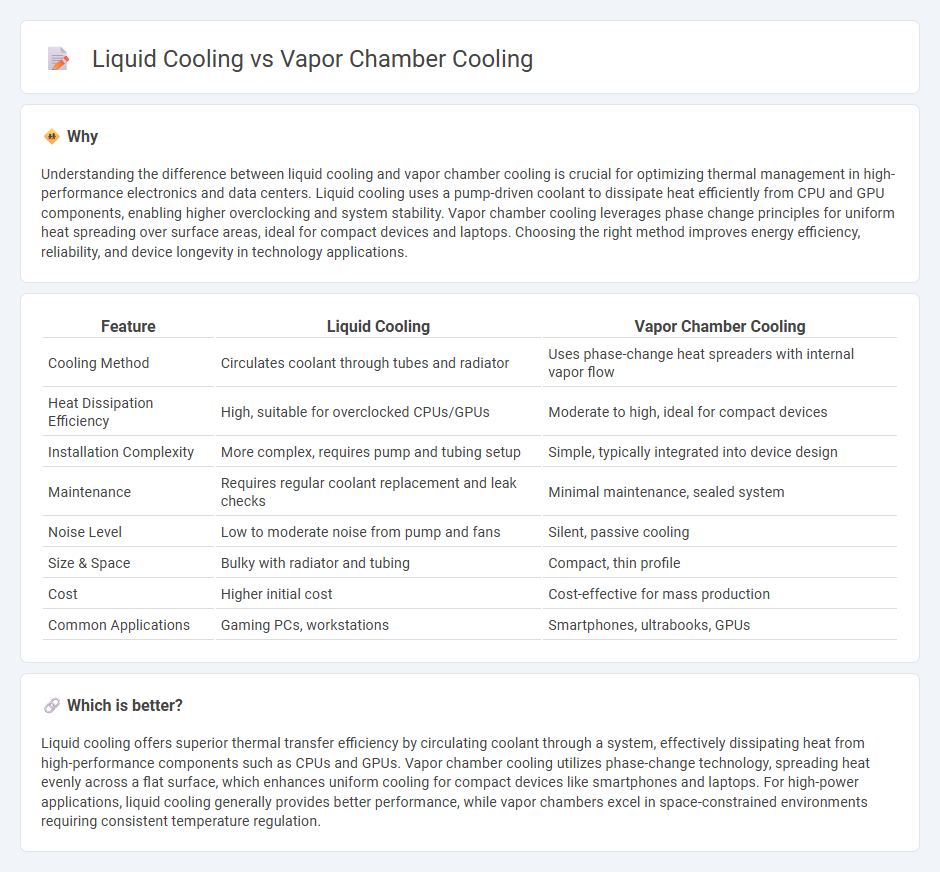
Liquid cooling uses a coolant circulated through tubes and radiators to efficiently dissipate heat from high-performance components, while vapor chamber cooling employs a sealed chamber filled with a working fluid that vaporizes and condenses to spread heat evenly across surfaces. Both technologies target enhanced thermal management in electronics, with liquid cooling favored for powerful CPUs and GPUs and vapor chambers commonly integrated into compact devices like smartphones and laptops. Explore the benefits and applications of these advanced cooling solutions to optimize your system's performance.
Why it is important
Understanding the difference between liquid cooling and vapor chamber cooling is crucial for optimizing thermal management in high-performance electronics and data centers. Liquid cooling uses a pump-driven coolant to dissipate heat efficiently from CPU and GPU components, enabling higher overclocking and system stability. Vapor chamber cooling leverages phase change principles for uniform heat spreading over surface areas, ideal for compact devices and laptops. Choosing the right method improves energy efficiency, reliability, and device longevity in technology applications.
Comparison Table
| Feature | Liquid Cooling | Vapor Chamber Cooling |
|---|---|---|
| Cooling Method | Circulates coolant through tubes and radiator | Uses phase-change heat spreaders with internal vapor flow |
| Heat Dissipation Efficiency | High, suitable for overclocked CPUs/GPUs | Moderate to high, ideal for compact devices |
| Installation Complexity | More complex, requires pump and tubing setup | Simple, typically integrated into device design |
| Maintenance | Requires regular coolant replacement and leak checks | Minimal maintenance, sealed system |
| Noise Level | Low to moderate noise from pump and fans | Silent, passive cooling |
| Size & Space | Bulky with radiator and tubing | Compact, thin profile |
| Cost | Higher initial cost | Cost-effective for mass production |
| Common Applications | Gaming PCs, workstations | Smartphones, ultrabooks, GPUs |
Which is better?
Liquid cooling offers superior thermal transfer efficiency by circulating coolant through a system, effectively dissipating heat from high-performance components such as CPUs and GPUs. Vapor chamber cooling utilizes phase-change technology, spreading heat evenly across a flat surface, which enhances uniform cooling for compact devices like smartphones and laptops. For high-power applications, liquid cooling generally provides better performance, while vapor chambers excel in space-constrained environments requiring consistent temperature regulation.
Connection
Liquid cooling and vapor chamber cooling both enhance thermal management by using phase change and heat transfer principles to dissipate heat efficiently. Liquid cooling circulates coolant through cold plates to absorb heat, while vapor chambers spread heat through a sealed, evaporative chamber with a wick structure. Integrating vapor chambers into liquid cooling systems optimizes heat distribution and reduces thermal resistance, improving overall device performance.
Key Terms
Heat Spreader
Vapor chamber cooling offers superior heat dissipation across the heat spreader due to its uniform phase-change mechanism, efficiently transferring thermal energy away from hotspots with minimal thermal resistance. Liquid cooling typically involves direct heat exchange through coolant channels, but may result in less even heat distribution across the spreader compared to vapor chambers. Explore the nuances of heat spreader performance in advanced thermal management systems to optimize your cooling solution.
Thermal Conductivity
Vapor chambers exhibit significantly higher thermal conductivity than traditional liquid cooling systems, often reaching values up to 10,000 W/m*K compared to liquid cooling's typical range of 400 to 600 W/m*K. This exceptional thermal performance enables more efficient heat spreading and dissipation, which is crucial in high-performance electronics and data centers. Explore the advantages of vapor chamber cooling and understand when it outperforms liquid cooling for advanced thermal management.
Pump Mechanism
Vapor chamber cooling relies on phase-change heat transfer with no pump, utilizing capillary action to circulate the coolant within a sealed chamber, enhancing thermal conductivity compared to traditional heat pipes. Liquid cooling systems depend on active pumps to circulate coolant through tubes and radiators, effectively dissipating heat but requiring power and maintenance for pump operation. Explore detailed comparisons of pump efficiency and system reliability in advanced cooling technologies.
Source and External Links
What is Vapor Chamber Cooling? - Vapor chamber cooling is a flat, sealed device filled with a small amount of fluid that evaporates under heat, spreading vapor evenly across the chamber to transfer heat away from the source more efficiently than traditional heat sinks or pipes, especially useful in high-performance electronics.
How vapor cooling keeps your smartphone from overheating - In smartphones, a thin vapor chamber absorbs heat from the chipset, turns fluid into vapor that travels to cooler regions to condense and release heat, then returns as liquid to repeat the cycle, enabling effective heat dissipation in slim devices.
Vapor Chamber Technology - Celsia Inc. - Vapor chambers are planar two-phase heat spreaders that use a vacuum-sealed chamber with a wick structure to rapidly move vapor from the heat source to a condenser, offering superior thermal performance for high-power, space-constrained applications compared to traditional heat pipes.
 dowidth.com
dowidth.com